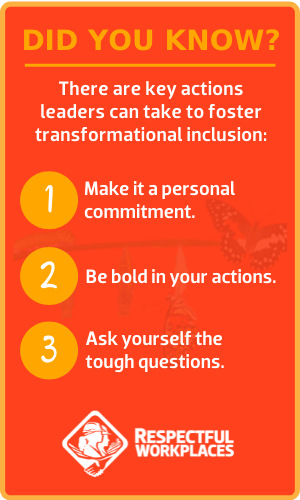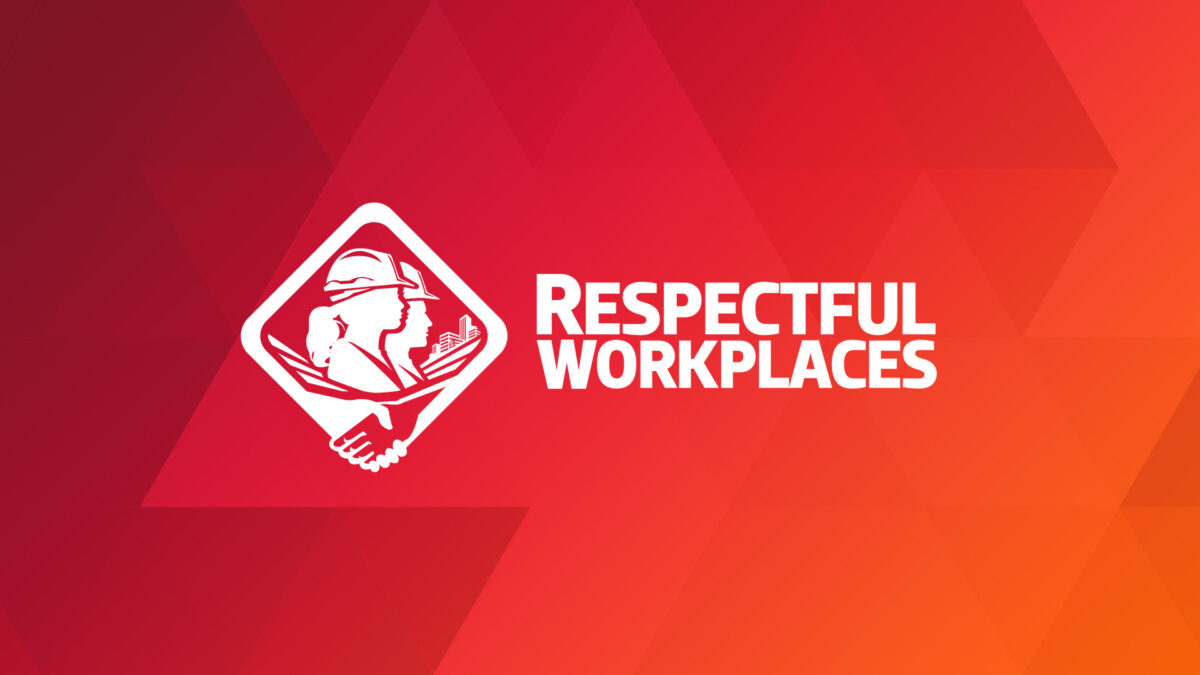Does your organization understand the role of leaders in fostering transformational inclusion?

As we celebrate Black History Month in February, statistics indicate that although many organizations have made commitments to address racism and discrimination against Black Canadians, more needs to be done.
According to the BlackNorth Racial Equity Playbook:
- 83% of Black Canadians say they believe Black people are treated unfairly at least sometimes.
- 60% of Black employees report having been discriminated against because of stereotypes related to their intellectual ability.
- 88% of Black employees say that their company isn’t doing enough to improve diversity and inclusion.
- Only 39% of Black Canadians agree that their organization has the right mechanisms in place to ensure major promotion decisions are free of bias.
- A significant wage gap exists for Black Canadians, even with the same education credentials as white Canadians.
What can organizations do to address these inequities and become more inclusive of Black people and other racial minorities?
Our readers will remember from Blog #58 that it will take more than a “business-as-usual” approach to create an inclusive organization.
To make progress, organizations will need to pursue transformational inclusion: bold action and systemic transformation led by committed leaders.
How can leaders help to foster transformational inclusion?
There are three initial key actions that leaders can take to foster transformational inclusion: 1) make it a personal commitment; 2) be bold in your actions; 3) ask yourself the tough questions.
1. Committed leaders recognize and address their own biases.
Creating transformational inclusion starts at the top. It is impossible to overestimate the importance of visible and active leadership by committed leaders. They must role model the behaviour they want to see throughout the organization.
According to research, the biggest challenge in addressing systemic racism is reducing unconscious bias, both at the individual level and the systems level. And although everyone has biases (please refer to blog #46 for a discussion of unconscious bias) their impact increases with the level of power a person holds.
Because of their influence throughout an organization, it is critical that leaders recognize and address their own unconscious bias. However, most people, leaders included, find it difficult to recognize or accept the fact that they have biases. This is the “bias blindspot:” as individuals, we have a tendency to not believe that bias is influencing our decisions, or we comfort ourselves by believing that we are not as biased as other people.
This has consequences for progress on an organization’s inclusion efforts. People with a strong bias blind spot are those most likely to ignore the advice of peers or experts, and are least likely to learn from de-biasing training that could improve the quality of their decisions.
Committed leaders accept the fact that they have biases. They recognize that they won’t be able to make decisions that are based solely on merit if they have blindspots about their own biases. Even when they intend to be inclusive, their unconscious bias can influence behaviour, both at the interpersonal level in their interactions and at the systems level in the processes that they develop. The only way to separate bias from behaviour is to make unconscious bias, conscious.
2. Bold action is needed to create an environment where inclusion can thrive.
Transformational inclusion will only occur in an environment of trust in which people feel safe to engage in difficult conversations about their personal biases, about the discrimination they experience at work, and the impact of these factors on their lives.
According to Simon Sinek, author of “The Infinite Game,” building a culture based on trust takes a lot of work.
First, individuals must feel safe expressing themselves and their vulnerabilities. They must understand that they are not infallible, will occasionally make mistakes, and may need to ask for help at times; and they must have the confidence that their boss and/or colleagues will support them.
This is the environment in which inclusion can thrive. Black, Indigenous, and People of Colour will feel safe to discuss discrimination or systemic bias that they may experience. In this environment, they know that change is possible because their boss and colleagues support them.
But it’s not enough for leaders to simply create an environment that is safe for telling the truth; they must model the behaviour they want to see. They recognize and address their own biases, actively incentivize the kinds of behaviours that build trust, give people responsible freedom to do their jobs, and provide the support people need to speak up with ideas, questions, concerns, or mistakes without fear of negative consequences.
3. Systemic transformation needs answers to tough questions.
To ensure equal access to opportunities and career success for Black, Indigenous, and People of Colour, more than simply training individuals about unconscious bias is needed. Organizations must also identify and reset the policies and processes that are embedded with unconscious bias. This process must be leader-led.
Ultimately, it is leaders who are responsible for every policy and process in an organization. They role model inclusion when they lead the process to identify where the obstacles exist and the strategy for removing them.
Bias embedded in formal and informal processes of recruitment, retention, and advancement has the most impact on an organization’s ability to be inclusive.
Asking tough questions about those processes will be transformational:
- Does our brand attract Black, Indigenous, and People of Colour?
- Do Black, Indigenous, and People of Colour feel good about our organization?
- Are we attracting and retaining high-potential Black, Indigenous, and People of Colour?
- Does our day-to-day environment actively promote inclusion and success for Black, Indigenous, and People of Colour?
- Do Black, Indigenous, and People of Colour communities view our organization as inclusive?
Addressing systemic racism takes more than a “business-as-usual” approach; it takes transformational inclusion. However, for this to happen, leaders must model the behaviour they want to see. They have the power to foster transformational inclusion by addressing their own bias blindspots, creating an environment of trust, and by asking themselves some tough questions.
Leaders and managers committed to transformational inclusion may wish to participate in the Introduction to Understanding Systemic Racism: A Guide for Leaders and Managers online course. This course helps learners understand systemic racism, unconscious bias, systemic bias, and the practical steps needed for long-term structural change in their organizations.
The BuildForce Respectful and Inclusive Workplace Toolkit provides a suite of tools based on the proven practices of respectful and inclusive organizations:
• Online Self-Assessment Tool
• Policy Framework and Implementation Guide
• Working in a Respectful and inclusive Workplace online course
• Introduction to Understanding Systemic Racism – A Guide for Leaders and Managers online course
For more info:
- BlackNorth Initiative and Boston Consulting Group. “A Guide to Advance Racial Equity in Corporate Canada.” 2021. See: https://blacknorth.ca/playbook
- Deloitte. “Deloitte Global 2021 Millennial and Gen Z Survey.” See: https://www2.deloitte.com/global/en/pages/about-deloitte/articles/millennialsurvey.html
- Donovan, Mason and Mark Kaplan. The Inclusion Dividend, 2nd Ed. DG Press, New Hampshire, U.S., 2019.
- Kepinski, Lisa and Veronika Hucke. “Achieving Results: Diversity & Inclusion Actions with Impact.” Newsweek, 2017. See: www.newsweek.com/diversity-inclusion-actions-impact-download-workplace-articles-study-689453
- Sinek, Simon. The Infinite Game. Penguin Random House, U.S., 2019.
Read from the beginning. Click here to start at Part 1.
What can an effective Respectful and Inclusive Workplace Program deliver?
- Become an employer of choice – attract, retain, and advance top talent from all sources of labour
- Unlock collaboration and innovation – create high-performing teams through diversity of thought and experience
- Build your brand – your organization will gain a competitive edge as a leader and innovator
Get started today!
The BuildForce Canada Online Respectful and Inclusive Workplace Toolkit includes:
- the Respectful Workplace Online Self-Assessment Tool to assist organization leadership in assessing their current situation and identifying where they may need to make changes
- the Respectful Workplace Policy Framework and Implementation Guide to assist organizations in creating and implementing a policy that supports a respectful and inclusive workplace
- the Respectful Workplace Online Training Course to train workers on how to create and support a respectful and inclusive workplace
- the online course Introduction to Understanding Systemic Racism: A Guide for Leaders and Managers
All the resources you need to create and support a respectful and inclusive workplace!

Respectful and Inclusive Workplaces
